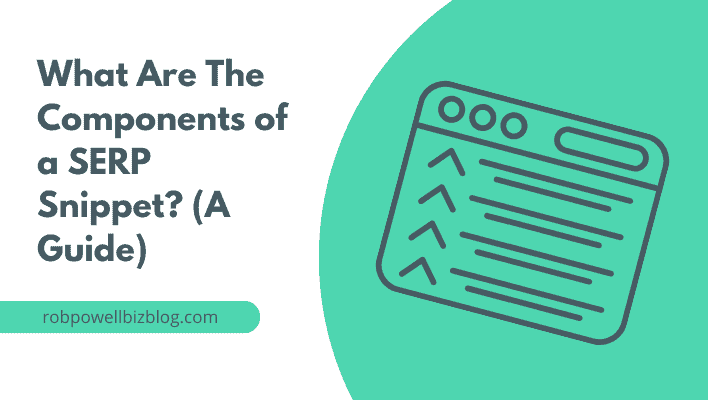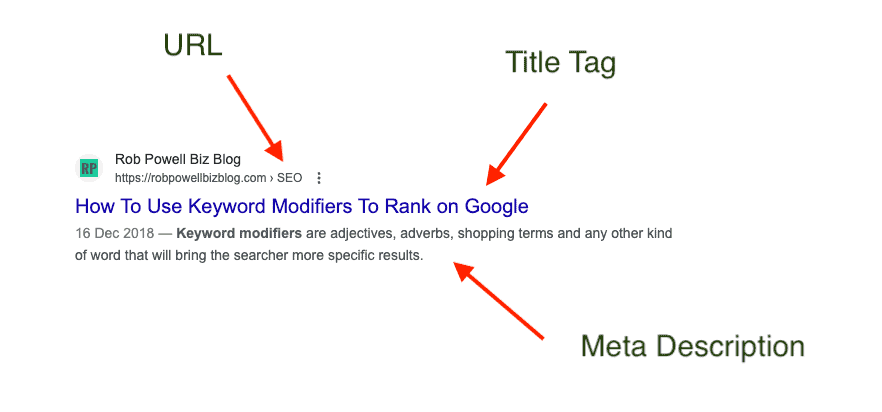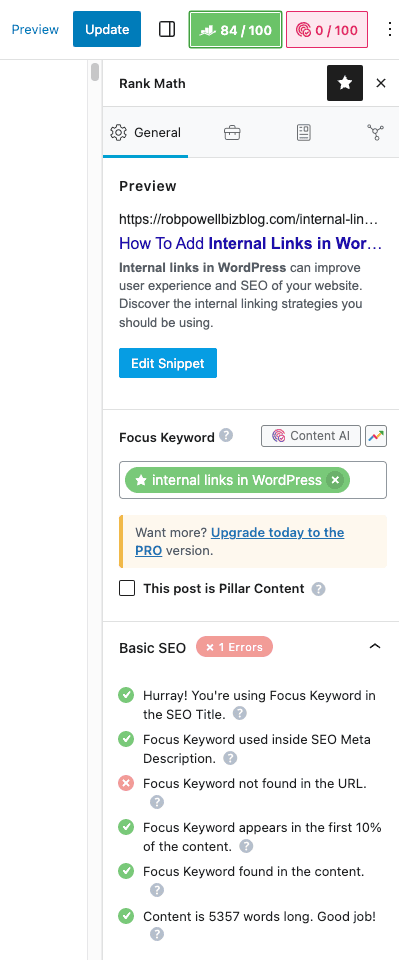You know what I’m talking about – type a query into Google and out pops a list of results, each containing a small piece of information that just screams “Click me!”
What you’re looking at is a SERP (Search Engine Results Page) snippet, and if you’ve ever wondered what goes into that tantalizing tidbit of information, you’re in the right place.
Now, I know what you’re thinking. “SERP snippets? Sounds technical. Maybe even a bit dry.” But trust me, understanding these components is like having a backstage pass to the inner workings of search engine results.
In this article, we’re going to take a deep dive into the components of a SERP snippet. We’ll explore what they are, how they work, and why they matter to anyone wanting to win the game of online visibility.
So grab a coffee (or a green tea if you’re like me), and let’s get started. You’re about to enter the surprisingly engaging world of SERP snippets, and I’ll be your guide.
It’s SEO but with all the boring bits taken out.
Ready? Let’s dive in.

Understanding Your SERP Snippet
So what exactly is a SERP snippet?
Definition of SERP Snippet
A SERP snippet is a brief summary of a webpage’s content that appears on the search engine results page (SERP). It includes the page’s title, URL, and a brief description of the content.
A SERP snippet is like the elevator pitch for a webpage. Think of it as a movie trailer; it’s short, snappy, and designed to get you interested.
The SERP snippet is an essential component of the search engine results page because it is the first point of contact between the user and the webpage.
SERP snippets are the handshake between the user and the webpage. Nail that first impression with a well-crafted snippet, and you’ve got yourself a click. Fumble it with something uninspiring, and you might just lose a potential visitor.
That’s why you should spend some time and energy on the various components that go into your SERP snippet.
Let’s look now at what makes up a SERP snippet.
Key Components of a SERP Snippet
A SERP snippet has three main elements: the title tag, URL, and meta description. Let’s look at each of these components.

Title Tag
The title tag is the clickable headline that appears in blue on the SERP. It’s the first thing you see when you search for something on a search engine. The title tag should be relevant to the search query and give the user a clear idea of what they can expect to find on the page.
It’s important to note that the title tag is limited to a certain number of characters (usually around 60-70). It’s a good idea to keep your title tag within this limit so that it doesn’t get cut off on the SERP.
URL
The URL is the web address of the page that appears in green on the SERP. It’s important to have a clean and concise URL that accurately reflects the content of the page.
Having a clear URL structure can make it easier for users to navigate your website and can also improve your search engine rankings. It’s a good idea to include relevant keywords in your URL, but avoid using too many keywords as this can be seen as spammy.
Meta Description
The meta description is a brief summary of the content that appears below the title tag on the SERP. It’s important to have a well-written meta description that accurately reflects the content of the page and entices users to click through to your website.
Like the title tag, the meta description is also limited to a certain number of characters (usually around 155-160). It’s important to make the most of this limited space by including relevant keywords and a clear call-to-action (CTA).
In summary, the key components of a SERP snippet are the title tag, URL, and meta description. By optimizing these components, you can improve your search engine rankings and attract more traffic to your website.
Additional Components of a SERP Snippet
SERP snippets may also have a few additional components. These extra elements can help make your listing stand out and provide more information to the searcher. In this section, we’ll cover four common additional components: Rich Snippets, Featured Snippets, Sitelinks, and Knowledge Graphs.
Rich Snippets
Rich snippets are a type of SERP feature that can enhance your listing by adding a visual layer to an existing result. This can include things like review stars for product ratings, recipe images and ratings, or event dates and times. Rich snippets can help your listing stand out and provide more information to the searcher before they even click through to your site.
To have rich snippets appear in your SERP listing, you’ll need to add structured data markup to your site’s HTML. This markup tells search engines like Google what type of content is on your page and how it should be displayed in search results.
Featured Snippets
Featured snippets are large boxes that highlight a specific section of a webpage and present that section inside of the results themselves. They usually appear at the very top of the page, below the ads, and can include things like definitions, step-by-step instructions, or lists.
Featured snippets are a great way to provide quick answers to searchers’ questions and can help increase your site’s visibility and authority. To have your content featured in a snippet, you’ll need to create high-quality content that answers a specific question or provides a clear solution to a problem.

Sitelinks
Sitelinks are hyperlinks to website subpages that sometimes appear in Google search results. They are designed to help users navigate the site more easily by directly linking to the most important or relevant pages of the site.
Sitelinks can be a helpful way for businesses to guide users to specific content, like products, contact information, or frequently asked questions. They are usually generated automatically by Google’s algorithms, although webmasters can influence them through proper website structure and SEO practices.
Sitelinks typically appear for searches where a particular website is the top-ranking result and when the search engine determines that the user’s query would be best served by displaying these additional links.

Knowledge Graphs
Knowledge Graphs are a type of SERP feature that provides quick, factual information about a specific entity, such as a person, place, or thing. This can include things like a brief overview, key facts, and related entities.
To have your content appear in a Knowledge Graph, you’ll need to focus on creating high-quality content that provides clear and accurate information about the entity in question. You can also use structured data markup to help search engines better understand the content on your site and improve your chances of appearing in a Knowledge Graph.
Overall, incorporating additional components like Rich Snippets, Featured Snippets, and Knowledge Graphs into your SERP listing can help increase your site’s visibility, authority, and relevance. By providing more information and answering searchers’ questions directly in the search results, you can improve your chances of attracting clicks and driving traffic to your site.
The Role of SERP Snippets in Click-Through Rate (CTR)
When it comes to search engine optimization (SEO), SERP snippets play a crucial role in attracting potential visitors to your website. SERP snippets are the brief descriptions that appear below the title of a webpage on a search engine results page (SERP). They provide users with a quick overview of what the webpage is about and can help them decide whether or not to click through to your site.
You know how you’re always looking to get more people to visit your website? Well, that’s where SERP snippets come into play. They’re basically little ads for your website. It’s the SERP snippets that make people decide if they want to click through to your site or not.
Here are a few reasons why SERP snippets are so important:
- Increased visibility: A well-crafted SERP snippet can help your webpage stand out from the competition and attract more clicks from users. This can lead to increased visibility and higher rankings on the SERP.
- Improved click-through rates (CTR): If your SERP snippet accurately reflects the content of your webpage and entices users to click through, you’re likely to see an improvement in your CTR. This can lead to more traffic to your site and potentially more conversions.
- Opportunity to showcase your brand: Your SERP snippet is an opportunity to showcase your brand and differentiate yourself from the competition. By crafting a unique and compelling snippet, you can help users recognize your brand and build trust with potential customers.
To make the most of your SERP snippets, it’s important to keep them concise, relevant, and engaging. Use your target keywords in the snippet, but make sure it reads naturally and isn’t stuffed with too many keywords. Consider using bold text or bullet points to draw attention to key points in your snippet. And don’t forget to update your snippets regularly to reflect any changes to your webpage content.
One factor that can really make your SERP snippet stand out and give you a competitive advantage over other sites is structured data.
Let’s look at this in more detail.
SERP Snippets and Structured Data
Structured data, also known as schema markup, is a powerful tool in SEO that can help you optimize your SERP snippets. It provides search engines with specific information about the content on your page, allowing them to create more detailed and informative snippets. SERP snippets with structured data are referred to as ‘rich snippets’.

Here’s how rich snippets can improve your SEO:
- Enhancing Visibility with Rich Snippets: By adding schema markup, you can create rich snippets that display additional information in the search results, such as ratings, prices, or availability. This added detail can make your listing more appealing and eye-catching, leading to higher click-through rates.
- Improving Relevance: Schema markup helps search engines understand the context of your content, making it more likely that your snippet will be displayed for relevant queries. By accurately categorizing your content, you can ensure that the right users find your page.
- Increasing CTR (Click-Through Rate): Rich snippets provide users with more information at a glance, helping them decide whether to click on your link. The additional details can lead to an increase in the click-through rate, as users are more informed about what they will find on your page.
- Providing Accurate Information: With structured data, you can specify particular elements of your content such as the author, publish date, product information, etc. This helps search engines display the most relevant and accurate information in the snippet, improving the user experience.
- Supporting Various Content Types: Schema markup supports a wide variety of content types, including articles, products, events, recipes, and more. By using the appropriate markup for your content, you can have customized rich snippets that align with your content’s specific attributes.
- Enhancing Local SEO: If your business has a local presence, you can use local business schema markup to display specific information like address, phone number, or operating hours. This can make your snippet more relevant to local searchers and increase visibility in local search results.
- Facilitating Voice Search: As voice search becomes more prevalent, structured data helps voice search devices provide accurate and detailed responses. By marking up your content, you can increase the chances of your information being used in voice search results.
- Creating a Competitive Edge: Not all websites utilize schema markup, so implementing it on your site can give you a competitive advantage in the SERP. The enhanced appearance of your snippet may draw more attention and clicks than standard listings.
- Allowing for Quick Updates: If information changes (like the price of a product), structured data makes it easier for search engines to recognize and reflect those changes in the snippet quickly.
- Building Trust with Users: Displaying detailed and accurate information in the snippet can help build trust with users, as they can see essential details about your content even before clicking through.
Structured data offers a multifaceted approach to optimizing your SERP snippets by enhancing visibility, relevance, and user engagement. By taking advantage of this tool, you can create more appealing and informative snippets that can lead to increased traffic and conversion rates.
For information on how to add structured data to your website, see my article: Rich Snippets For WordPress (How To Add Them In 3 Mins Flat)
How To Optimize Your SERP Snippets
As you will have guessed by now, optimizing your SERP snippet is a vital part of SEO.
Here are some tips for optimizing your SERP snippets:
- Include your target keyword: Make sure your target keyword appears in both your SEO title and meta description. This will help improve your relevance and visibility in search results. I always try to use my main keyword at the start of the SEO title and as close as possible to the start of the meta description.
- Keep it concise: Your SEO title should be no longer than 155 characters. This is the maximum length that Google will display in search results, so make sure your snippet is short and to the point. Highlight the most important aspects of the webpage’s content. From my personal observations, Google seems to have a preference for shorter titles.
- Highlight unique selling points: Use your SERP snippet to highlight what makes your website unique. This can include things like free shipping, a money-back guarantee, or a unique product or service.
- Include a number: Try to include a number and/or a symbol in the SEO title of your SERP snippet. Numbers get processed quicker than letters by the human brain, and they stand out.
- Include the current year in your title: Including the current year in your blog post title can significantly enhance your SEO performance. Many users search for up-to-date information and add the current year to their search queries. By incorporating the year in your title, you signal to both search engines and users that your content is recent and relevant to current trends or information. This can boost your rankings for time-sensitive queries and increase click-through rates, as users often prefer the most current information available.
- Include a call to action: Encourage users to click on the link by using action-oriented language. Use action verbs such as “Learn” or “Read” “Discover,” or “Explore.”
- Highlight unique features: If the webpage has unique features or offers something that other pages do not, highlight those features in the snippet to make it stand out.
- Avoid clickbait: While it is important to create an enticing snippet, avoid using clickbait or misleading language that does not accurately reflect the content of the webpage.
- Use a table of contents: Adding a table of contents to your blog post isn’t just useful for your readers; it can also benefit your search engine ranking. Google may recognize the structured layout and feature hyperlinks to the specific sections of your post right in the Search Engine Results Page (SERP) snippet. This makes your content more accessible to searchers and can increase click-through rates by allowing users to jump directly to the information they need. Consider implementing a table of contents to improve both user experience and search visibility.
When writing your SEO title, which is the most important part of your SERP snippet, I highly recommend using Co-Schedule’s free Headline Studio. Keep modifying your title until you get a green score (80 out of 100 and above)
By following these tips, you can create effective SERP snippets that accurately reflect the content of your webpage and result in higher click-throughs from the search results.
Common Mistakes
Here are some common mistakes to avoid when optimizing your SERP snippet:
- Keyword stuffing: Don’t stuff your SERP snippet with keywords. This can make your snippet look spammy and can actually hurt your visibility in search results.
- Failing to Include the Focus Keyword: If there’s a particular keyword you’re targeting, make sure it’s included in the snippet. This helps users and search engines connect the snippet with the content on the page.
- Being too vague: Don’t be too vague in your SERP snippet. Make sure you clearly communicate what your page is about and what users can expect to find on your website.
- Misleading users: Don’t mislead users with your SERP snippet. Make sure your snippet accurately reflects the content of your page. If users feel misled, they may leave your website quickly, which can hurt your rankings.
- Ignoring the Character Limit: Snippets have a specific character limit, which may vary across different search engines. If your snippet is too long, it might get cut off, leaving users with incomplete information. Stick within the recommended limit, which is typically around 150-160 characters for the meta description.
- Lacking a CTA (Call to Action): Including a compelling CTA can encourage users to click on your link. Without this, you might miss a chance to guide the user to take the desired action.
- Not Using Structured Data: Implementing structured data, such as schema markup, helps search engines understand the content better and can lead to enhanced snippets (like rich snippets). Ignoring this can mean losing out on opportunities to stand out in the SERP.
- Duplicate Meta Descriptions: Using the same meta description across multiple pages or posts can lead to lower click-through rates, as users might perceive the content as repetitive or irrelevant. Tailor the meta description to the specific content of each page.
Overall, optimizing your SERP snippet is an important part of any SEO strategy. By following these best practices and avoiding common mistakes, you can create a compelling and informative snippet that drives more traffic to your website.
SERP Snippet Testing and Preview Tools
There are several tools available for testing and previewing SERP snippets. These tools allow you to see how your website’s title tag, meta description, and URL will appear in search engine results pages (SERPs).
Here are some free tools that allow you to preview your SERP snippet:
There are also WordPress plugins that will show you what your SERP snippet will look like for any given page or post. The two most popular of these plugins are Yoast SEO and RankMath.
RankMath gives you a preview of what your snippet will look like in the SERPs:

Make sure your title, permalink, and meta description are all within the recommended number of characters.
RankMath also gives you a score out of 100 which indicates how well your SERP snippet will perform in the search results:

Yoast SEO is similar to RankMath (and was around a long time before RankMath) – it also gives you a preview of your SERP snippet. Yoast uses a ‘traffic light’ system to tell you if your SERP snippet is optimized for the search results.
RankMath and Yoast SEO both have free and paid versions, but the free versions of both plugins will do everything I’ve just described above.
Conclusion
To wrap things up, the components of a SERP (Search Engine Results Page) snippet aren’t just part of the background noise in SEO. They’re front and center, shaping how users find and interact with your content online.
We’re talking about everything from the title and URL (which hooks your audience) to the meta description and rich snippets (like those star ratings and eye-catching images) that pull them in further. And here’s the thing: as search engines get smarter, these components only get more critical. You can’t just know about them; you have to master them.
And that’s what this guide is for. It’s not just a rundown of the parts; it’s a roadmap to turning them into a coherent strategy that works. SEO isn’t standing still, and neither should you. By diving into the nitty-gritty of SERP snippets, you’re positioning yourself to stay ahead of the curve, meet the demands of today’s users, and drive meaningful engagement with your content.
And that’s a win, I think you’ll agree.
Frequently Asked Questions
What is included in a typical SERP snippet?
A typical SERP snippet consists of a title, URL, and a brief description of the webpage’s content. It is designed to provide users with a quick overview of the web page’s content and relevance to their search query.
What are the main components of a SERP snippet?
The main components of a SERP snippet are the title, URL, and description. The title is the clickable link that appears at the top of the snippet, and the URL is the web address that appears below it. The description is a brief summary of the webpage’s content that appears below the URL.
What are the essential elements of a SERP snippet?
The essential elements of a SERP snippet are the title, URL, and description. These elements work together to provide users with an accurate and concise summary of the web page’s content and relevance to their search query.
How does a SERP snippet differ from other SERP features?
A SERP snippet differs from other SERP features in that it is a traditional organic result that appears on the search engine results page. Other SERP features, such as featured snippets and knowledge panels, provide users with more detailed information about a particular topic or query.
What information is displayed in a SERP snippet?
A SERP snippet displays the title, URL, and description of a webpage. It may also include other elements such as sitelinks, breadcrumbs, and rich snippets, depending on the relevance and quality of the webpage’s content.
What are the key factors that determine the content of a SERP snippet?
The key factors that determine the content of a SERP snippet are the relevance and quality of the web page’s content, as well as the user’s search query. Search engines use complex algorithms to analyze and evaluate webpages, taking into account factors such as keyword usage, content quality, and user engagement.
- SEO Powered Content & PR Distribution. Get Amplified Today.
- PlatoData.Network Vertical Generative Ai. Empower Yourself. Access Here.
- PlatoAiStream. Web3 Intelligence. Knowledge Amplified. Access Here.
- PlatoESG. Automotive / EVs, Carbon, CleanTech, Energy, Environment, Solar, Waste Management. Access Here.
- PlatoHealth. Biotech and Clinical Trials Intelligence. Access Here.
- ChartPrime. Elevate your Trading Game with ChartPrime. Access Here.
- BlockOffsets. Modernizing Environmental Offset Ownership. Access Here.
- Source: https://robpowellbizblog.com/components-of-a-serp-snippet/




